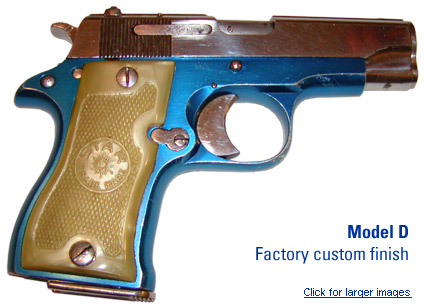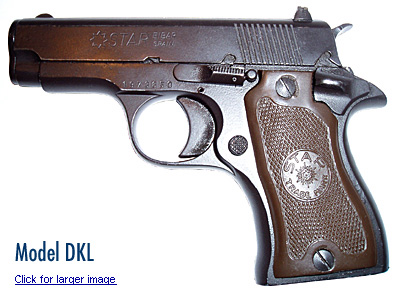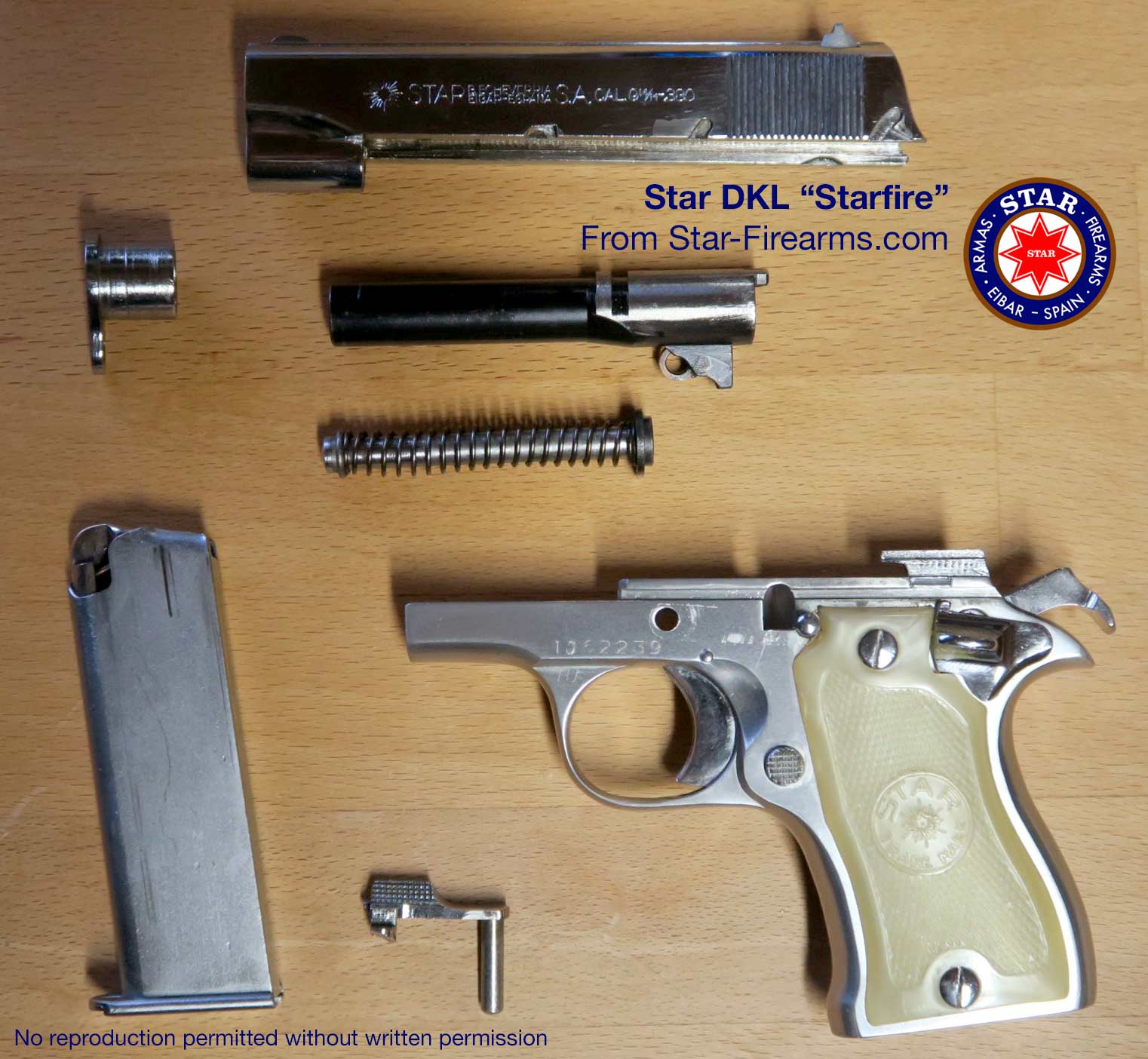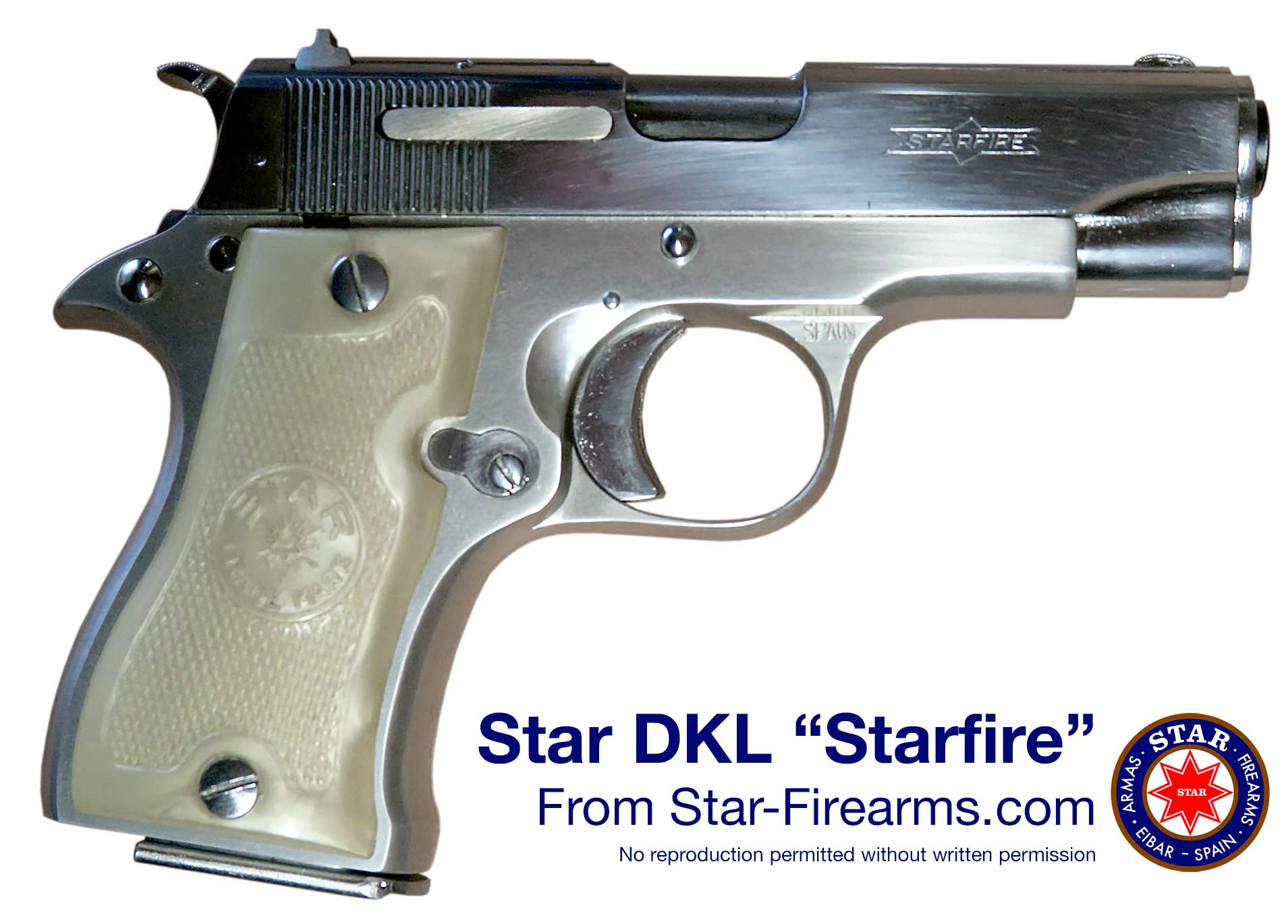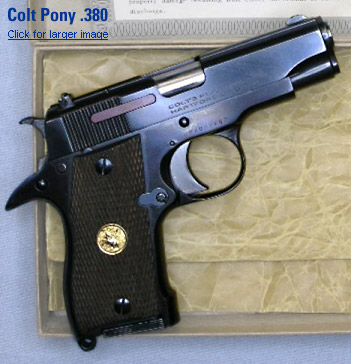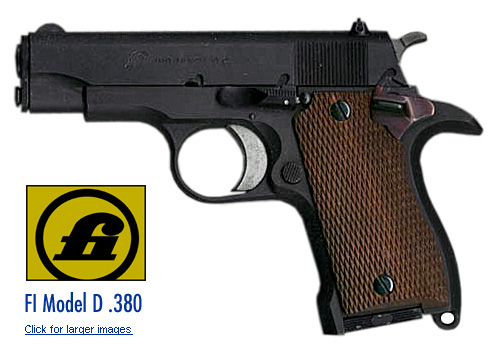Star Firearms — D-Series Pistols
The D series is a compact, .380 ACP (9 mm Browning Short) caliber variants of the model A/B series of 1911-inspired Star pistols. It is apparently designed for commercial sales as a self-defense weapon. All D-series weapons seem to be of approximately the exact same external configuration, with the same length slide and gripframe, a semi-circular front sight and so on.
The alloy-framed DKI was in .32 (7.65 mm) caliber. Star's intentions with its compact pistols are not entirely clear when you compare the D and S series. The D seems to be simply a slightly smaller gun, but it is actually slightly heavier in weight and bulk, despite its reduced length. Also, the D has a full-legth guide rod, and a different (but still removable) barrel bushing. There are other detail differences in the design that would seem to have led to it being dropped at some point, but instead it was retained for reasons I cannot yet fathom. Since .32 was more common for European compact issue and defense weapons, it may have been intended for a specific export market.
The only visible variations I have seen are in grips, which could be wood, wood with medallions or checkered plastic with the Star logo. All pistols also have a sturdy lanyard loop integral with the frame. This is another unusual feature, for no apparent specific reason. Frames were made in alloy as well as steel, and
As dates of manufacture and other details are quite unclear, any information that you can share with me about your own model D pistol would be welcome. Date codes especially would be nice to gather, so I can determine when it was really made.
Manuals & Disassembly Instructions
I do not have manuals for every pistol shown on this site. However, in many cases there is a related manual. Partly to make the series relationships clearer, and partly to assist with speed and accuracy of updating, all manuals can be found in one place, the manuals page. All manuals available are provided as downloadable PDFs, or you may purchase a printed copy of the entire set of handgun manuals.
All Classic series pistols strip in the same way. Do not the significant differences between older swinging-link and later "Super" variations.
First Model D
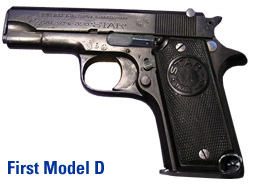
A number of early Star compact pistols, even when derived from the A/B series, seem to have been produced for brief periods with a pocket pistol control layout before they moved to adopting the Colt style safety at the rear. A model D of this type was apparently made from 1922-32. While most of these models also had no slide lock, at the least a first model D produced around 1931 did have this, as well as the vest-pocket style safety lever.
The safety lever is behind the trigger, with a hinge under the left grip panel. Unlike on the other, smaller guns, with just a red dot to fire, this has F & S marks for each position. There is also a lanyard protruding from the left side, in the nature of many service pistols of this era. Note that the photo accompanying this description did not have the slide lock, safety lever or lanyard ring. I added these via photoshop, so take these details with a grain of salt. I am particularly suspicous of the safety lever, as the conventional style leaves a detent hole exposed. All other features, however, are accurate.
Also note the frame shape is more akin to other, older pistols, with a straight frontstrap (no bulge at the bottom) and a straight backstrap, without the bulge seen later. Sights are different with the round pin for retention, the slide lacks the takedown notches as there is no safety lever to engage them, and the hammer is of the two-piece style with the riveted center portion.
Second Model D
In 1928 the more conventional control configuration was re-introduced, with a rear-mounted thumb safety on the left side. This gun remained in production until probably 1983. See the "rebranded variants" section for more information on ways to encounter a model D pistol. Other changes generally brought the pistol up to current standards, with an arched backstrap, one-piece hammer, conventionally mounted sights, and so forth.
There appear to be two slight variations on this pistol, apparently without a suffix to indicate them. What I believe are the older guns had a slide with a rounded, smooth top, and a conventional butt where a flat magazine floorplate protruded slightly past the end of the butt. The later models, including all rebranded US imports had a slide with a stepped top and a sort of wide, flat rib, and the magazine interfaced with the butt of the pistol differently. The frame encompasses the magazine, and only a small portion is available for grabbing to remove, via protruding, grooved panels.
Model D Super
Reported by only one source is a Model D Super, made in 1950, or maybe from 1950 onward. If these exist, I suspect they are exactly as other Super series pistols, identical in most details to the others in the series, but with closed cam path unlocking and a takedown lever on the right side.
DK, DKL & DKI
The DK version was an obvious step to take with the compact pistol when aluminum alloys became a real possibility in the 1950s. However, the rebranded versions discussed below all have steel frames, even when alternatively referred to as the "DK." This is not something I clearly understand just yet.
The DKL and DKI have some internal modification from the basic DK, but L in this context means nothing I am aware of. I suffixes indicate a .32 caliber variant.
Starfire
The DK – and possibly other variants – was also sometimes branded as "Starfire," in a prescient crossover of markings. The "DK" marks are on the butt as usual for Classic era guns, but the "Starfire" brand is on the right side of the slide, stylized, in much the way that Modern era Firestar, Megastar, or Ultrastar brands were marked.
There are no obvious difference in the style, design, features, accessories, or finishes. It appesrs to just be a brand variation.
Rebranded Variants: the Colt Pony, Iver Johnson .380 and FI Model D
All of these guns are mechanically identical to the Star branded DK models discussed above and differ only in the details mentioned below, and in their markings and marketing.
Colt
In the middle 1970s, Colt decided to offer a .380 auto, and chose to partner with Star instead of making their very own gun. The gun (to be called the Pony) was to be assembled in the US, presumably by Colt, from a Star DK slide & associated internals, with a U.S. made frame.
However, the fixed lanyard loop (to increase height of the gun) and the adjustable sights are typical of features added to get points for the 1968 Gun Control Act, which placed restrictions on importation of small handguns. This may indicate that the guns would be entirely made in Spain after all, and just imported with different markings.
Iver Johnson
For some reason, after this product was announced, the Colt/Star partnership was dissolved and very few Colt-branded guns seem to have been sold. Iver Johnson bought the U.S. manufacturing rights to the gun, and sold a number of them. Apparently quite a few frames were made in anticipation of the Colt deal, as all the early Johnson serial numbers start with "CPA" (Colt Pony Automatic). It is also possible that some slides were made in the U.S. by Iver Johnson (some manufacturing marks and methods vary), but all the small parts were Spanish imports by Star. Iver Johnson also made at least one commemorative edition based on the Model D Pony, for a US Border Patrol anniversary in 1994; these all have "USBP" serial number prefixes.
Some reports have Iver Johnson guns also being sold with the Starfire name. If true, this may simply be the result of how much of the production was Spanish parts; when Star began marking their slides "Starfire" they simply didn't make a special un-marked version for IJ. This is speculation of course, but it makes sense.
The Iver Johnson pistols have a slightly different frame shape, with a longer "beavertail" to keep the hammer from biting the shooter. The hammer is of the spur type, as a result of the guarding. The sights are smaller and the rear is micrometer adjustable, in contrast to the high visibility combat sights of the Star DK.
Firearms Interational (FI)
At some point, FI (Firearms International, not to be confused with FIE) acquired the rights and also sold the model D as an FI-made gun, with the model D designation. No Star branding or importation marks appear, so this may also be a related endeavour where an essentially Star pistol is sold under another name entirely. There are some reports of FI selling the import-marked version as the "Garcia Model 30" as well. This appears to be the same as the Iver Johnson guns, as far as manufacturing methods go, just marketed differently. It was still presumably largely made by Star and simply assembled on a US made frame.
